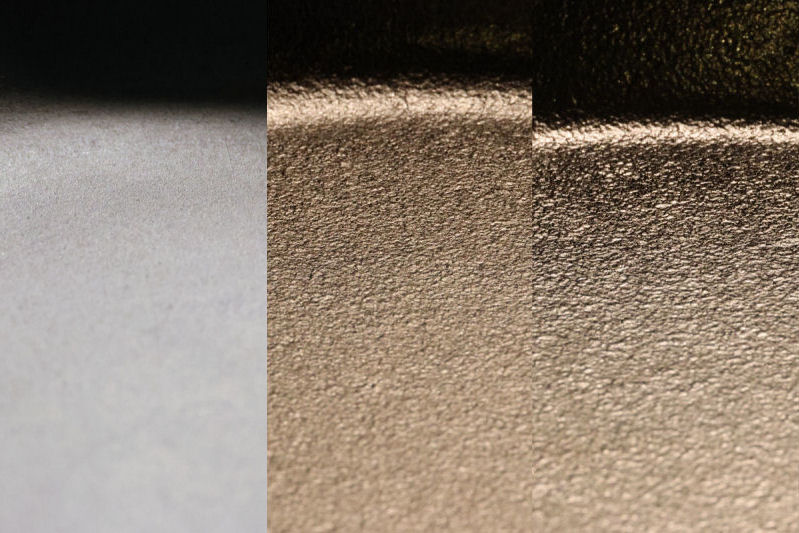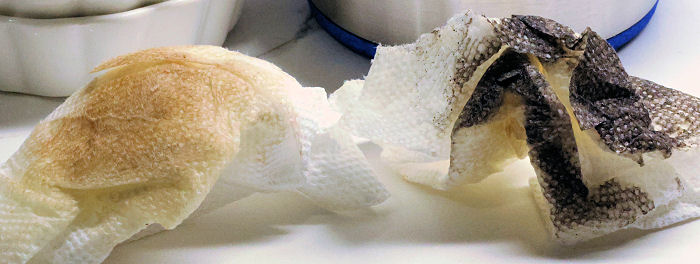 |
 |

Introduction
Most everyone who has some knowledge of vintage and modern cast iron skillets knows that the smoother
vintage skillets are superior to those produced today by Lodge Manufacturing. Or are they? There are
a lot of fans of Lodge skillets who claim that their pebbled surface and factory seasoning are just as
good if not better than the vintage skillets. Some claim that while the classic Lodge skillets aren't
all that special, the newer, more expensive Lodge Blacklock skillets are equal to if not superior to
the smooth finish of the vintage skillets. Well, this sounds like a challenge! We took 2 brand new
Lodge skillets and a freshly-seasoned vintage Lodge skillet and cooked what is a true test of the pan's
non-stick ability, scrambled eggs.
The Pans
We chose 2 Lodge skillets made in 2022 and a vintage Lodge skillet made between 1910 and 1930 for this test:
The Cooking Surfaces Up Close
Here we have close up photos of the cooking surface of each of the pans. For reference, the three
pans were photographed from the same distance with the same amount of magnification:
And here is a photo of a slice of each pan side by side, left to right Lodge Arc Logo, Lodge Classic, Lodge Blacklock:

Comments and Observations
The two modern Lodge pans have almost identical rough pebbly cooking surfaces. This is the
result of Lodge's choice to not machine the surfaces smooth after casting. The surface you
see is created by the sand mold. The only differences really are the color of the pans (the
Blacklock pan being more black in color) and the Blacklock pan being thinner than the Classic pan.
The surface of the vintage Lodge Arc Logo pan is almost as smooth as glass. This is the result of Lodge (and every other manufacturer of vintage cast iron) machining the surface back in the good old days. Had Lodge not performed this last step, their vintage skillets would have looked pretty similar to today's Lodge skillets. It is interesting to note that Lodge has been manufacturing cast iron skillets for over 100 years, and up until the 1960's or so, they machined the surface of their skillets just like every other manufacturer. Yes, Lodge really did make some fine cast iron skillets a long time ago.
As for the seasoning on the Lodge pans, Lodge says that the classic pan is seasoned with one coat of soybean oil. For the Blacklock pan, all they say is that it is "triple seasoned". Whatever they are doing, it is hard to believe that all they are using on the Blacklock pans is soybean oil. Where does the black color come from? We have seasoned a large number of pans starting from bare cast iron, and they never appear black after 3 seasonings. (And it's not the bare metal underneath that's black. More on that later.) It's only after a large number of cooks are done with the pans and some carbon starts to build up on the seasoning that you begin to see some black color form on the pan. Here's what wiped from the Lodge Classic and Blacklock pans after cooking scrambled eggs then cleaning and oiling:

Lodge states on their website, "Unlike other companies that use paint for a black sheen, Lodge seasoning is 100% natural. The oil is baked on during the manufacturing process, and the black patina that remains is a carbon deposit left by the oil on the skillet." However, like we said, we have never seen a properly seasoned pan turn black like the Blacklock pans from Lodge. Lodge also states that "Cast iron seasoning is a layer of carbonized oil." Uh, no. It is a layer, multiple layers in fact, of polymerized oil. Oh, well, we guess that we will never really know what Lodge is doing to season their Blacklock pans.
For our vintage Lodge Arc Logo pan, we use Field Company Seasoning Oil, made from organic grapeseed oil, organic sunflower oil and beeswax. It has been seasoned six times with this oil and is smooth and slick.
The Test
In order to test these freshly-seasoned skillets for the non-stick nature of their cooking surface, we chose
what is probably one of the more difficult tests for cooking pans, scrambled eggs.
Eggs have proteins in them that really like to bond with other things.
When the eggs hit the pan, they can form a chemical bond with the metal of the pan.
This is why we add fat to the pan and why we either season the pan or coat it with a non-stick coating.
Our method for testing was to whisk an egg in a bowl with a small amount of half and half. We then placed a pat of butter into the skillet and begin heating it over medium-low heat. We waited until the butter just started to brown, then we poured the egg into the pan and began stirring with rubber scraper. We stirred and turned the cooking egg over several times until the egg was done to our liking, which is soft scrambled. Finally, we used the rubber scraper to scrape the pan and move the egg from the pan to a plate.
Here is what the pans looked like after we scraped as much egg out of the pan as we could using a rubber spatula:
More Comments and Observations
Curiously, more egg seemed to stick to the "triple-seasoned" Blacklock pan than to the Classic Lodge pan.
But nonetheless, neither of the two modern Lodge skillets are anything like non-stick. And all those little
pebbly bits just seem to make things worse by giving the eggs more surface area to stick to.
On the other hand, you can see that not a single speck of egg stuck to the vintage Lodge pan. To clean the vintage Lodge pan, we simply wiped it out with a paper towel until most of the butter was gone. Then it went straight back into the kitchen cabinet with all our other vintage cast iron. Cleaning the two modern Lodge pans involved soaking with water and scrubbing with a chain mail cast iron scrubber.
What About More Seasoning?
Lodge doesn't provide detailed information on their seasoning process, as we have already shown, so
we wondered what would happen if the 2022 Lodge skillets were actually given a few rounds of
proper seasoning. Here's our method for seasoning antique cast iron pans from bare metal:
Now, we are getting somewhere! Both 2022 Lodge pans are now showing signs of actually acquiring a non-stick surface, almost as non-stick as the vintage Lodge pan.
Conclusions
So, sometime around the 1960's, Lodge decided to stop machining their skillets,
probably as a cost-cutting measure. The process of machining required a worker to
perform the operation on a machine one pan at a time. Instead they chose to reduce
costs and market their pebbly surfaced skillets
by claiming that the rough surface gives the seasoning more surface area to stick to. (In all fairness,
we'll point out that another major manufacturer of cast iron skillets (Wagner) also around that time
chose to stop machining their skillets.)
As we have seen, this is certainly true of scrambled eggs. But claiming that the rough surface gives
the seasoning more surface area stick to is more marketing than science.
Seasoning binds to the cast iron on a molecular level. Those pebbly bumps are the size of Mt. Everest
compared to the size of the molecules of polymerized oil. In fact, on Lodge's own website
is this statement:
"When oils or fats are heated in cast iron at a high enough temperature, they change from a wet liquid into a slick, hardened surface through a process called polymerization. This reaction creates a layer of seasoning that is molecularly bonded to the iron.They clearly state that seasoning binds to the iron on a molecular, microscopic level, not a pebble level. They acknowledge that a smooth surface is what you are after. They go on to state:On a microscopic level, cast iron has a jagged, uneven surface. This texture provides more surface area for the seasoning to bond and adhere to the iron. As the layers build up, the oils and fats will fill in the texture, creating a smooth, naturally nonstick cooking surface that will last for generations."
"The more you use cast iron, the smoother it becomes. Each time you cook with oil, the seasoning on your cast iron improves, making you cast iron darker and smoother. After a few years of regular use, the finish on your cast iron will be very smooth, similar to cast iron you might find at the flea market."So after a few YEARS of use, your Lodge pan might be as smooth as a vintage pan. And, they also suggest:
"Some customers prefer to smooth out the roughness, and it is okay to do so using fine grade sandpaper. Be sure to season the item promptly after doing so."Lodge touts the fact that they help you start the seasoning process by applying seasoning at the factory. Why not help you start the process by machining the pans smooth to begin with? You know? Like you did many years ago when you produced world class cast iron skillets? We're sure there are consumers who would be willing to pay the price to get a smooth non-stick seasoned cast iron pan without having to cook with the pan for several years, or sand the surface of the pan down with sandpaper. (There are quite a few modern companies producing machined cast iron skillets, but they are quite expensive. We can only imagine that Lodge could produce similar quality pans for a lot less due to their size.)
In light of what we have seen, both in cooking with these modern Lodge pans and what we have found on the Lodge website, we doubt we would ever choose to purchase a modern Lodge skillet. Vintage cast iron skillets are available on eBay for about the same price as Classic Lodge skillets and many different brands of vintage cast iron skillets are available for less than the Blacklock skillets. While some brands and types of vintage skillets can sell for enormous sums of money, many of them can be had for a relative pittance.
However, despite all of our ranting about modern Lodge pans, as we have seen, with some proper seasoning on top of the Lodge seasoning, you can have a pan that is almost as good as a vintage pan without sanding the surface smooth or waiting for a smooth surface to develop as the result of years worth of cooking. So the choice is yours. Do you want to own a modern piece of cast iron at a fairly reasonable price? Then visit the Lodge Cast Iron website. Or do you want to do a little digging and own a 100-year old piece of vintage cast iron? Then visit eBay or Etsy or one of the many cast iron selling groups on Facebook.
You can support this website by shopping at The Naked Whiz Website Store and Amazon.com
|